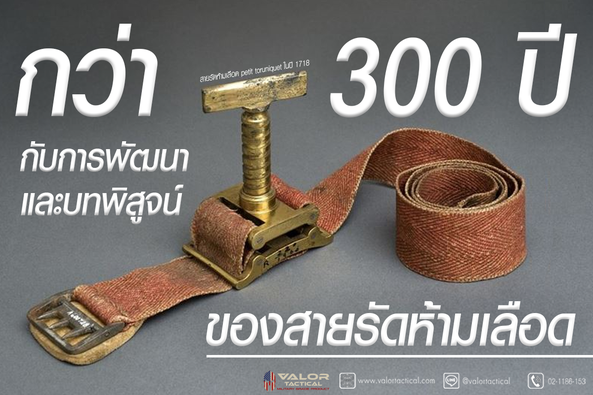Tourniquet is a piece of equipment that has been called both advantages and disputes for a long time on the topic that "It is a good device for saving lives, but it may cause organ loss." This matter has been proven today that if used correctly, it will be a very good life-saving device # and does not cause organ loss. But that is not what we will talk about today. The Tourniquet has been used more widely since the Afghanistan War and the Iraq War because it can save many soldiers' lives from ambushes and from IED bombs.
.
Before the tourniquet was first used, we used bandages and herbs to stop bleeding, a method we might have seen in movies. #In fact, tourniquets have been around since the Middle Ages, but they have been used in medicine, with clear historical evidence. In 1517, a German surgeon named Hans Von Gersdoff of Strasburg published a book about surgery called Feldtbuch der Wundtartzney . #In that book, it was mentioned and recommended the use of tourniquets. (If anyone has a real book or a copy for sale, please share a picture with us.)
.
#But if we only count military use, there will be a history recorded in the year 1674 by a surgeon of the French army named Etienne J. Morel who took bandages and/or rope and inserted a stick and twisted to stop the bleeding of the injured person until the bleeding stopped. And it has been used #but it is still only used in the military medical unit. It is not yet a device that everyone can use.

.
#The tourniquet revolution began in 1718 by French surgeon Jean Louis Petit who introduced the mechanism
And the threading system from nuts or screws was applied to the blood-stopping line until it was named Petit Tourniquet, which was widely popular in the medical field until S.Mar & Son, Ltd., a company that produced medical equipment, took it to produce further during the years 1860 - 1979 by adjusting the material from leather to fabric, which of course was used mainly in medicine in the form that was produced.


.
And when we go back to World War I and II, we see the Torniquet tourniquet used on the battlefield again, but it is in a form without a mechanism that uses nuts. Which is predictable that there is a problem in terms of portability for sure because it can be seen that it is a cloth strap about 1 inch wide and uses wood to twist. Which, by reducing the protruding part, makes it easy to carry. Reduces the metal material, making it lighter as well.
One of the images we posted is a record that says, “The Soviet Union had a campaign to get companies to design tourniquets for military use, which were used from 1941 to 1945 and then were phased out for rescue and medical use.

.
And then, continuing into the Vietnam era, we saw the Standard Issue tourniquets that came in many forms, such as webbing, etc.

Until it has been continuously developed
Until this era, it has become more efficient and easier to use, such as CAT Tourniquet, SOFT T, XT Tourniquet, TX, etc.
.
.
It can be said that Tourniquet or blood-stopping strap has proven itself through many eras in terms of saving lives on the battlefield and in accidents. There is continuous data and research, and most importantly, it is constantly developed to meet the needs of use more. But what remains the same is #saving lives and prolonging the lives of people as before.


.
If there is any incorrect information, I apologize here and let's talk and share. There is so much information that it is very difficult to summarize it for easy reading. Thank you for following.
.
For Valor Tactical itself, we are the distributor of first aid equipment from both brands that are standard and popular among armies around the world, including:
Tacticam Medical Solution and North American Rescue can view all products below under Credit.
.
For Valor Tactical itself, we are the distributor of first aid equipment from both brands that are standard and popular among armies around the world, including:
Tacticam Medical Solution and North American Rescue can view all products below under Credit.
.
Translated by Theetat Rinchai
Arranged by Thakoon Aree
References
.
Tourniquet Use on the Battlefield
Guarantor: MAJ Robert L. Mabry,
MC USA Contributor: MAJ Robert L. Mabry, MC USA
.
A brief history of the tourniquet
David R. Welling, MD, a Patricia L. McKay, MD, a Todd E. Rasmussen, MD, a,b and Norman M. Rich, MD, a Bethesda, Md; and Fort Sam Houston, Tex.



